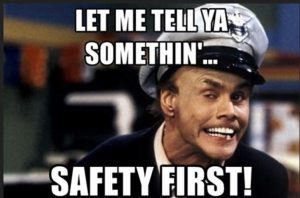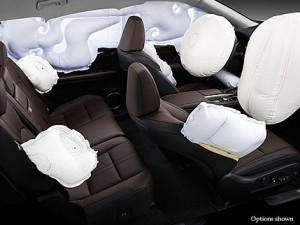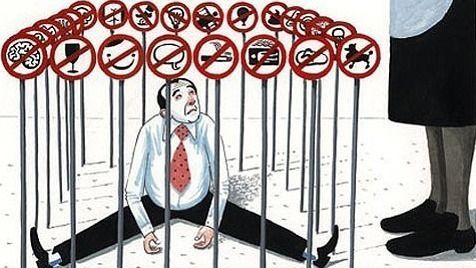It is perhaps reasonable to make the argument that the federal government’s regulation of vehicle exhaust emissions is legitimate. Up to the point after which the regulations cross over into unreasonableness.
This happened about 30 years ago.
But it has never been reasonable for the government to issue “safety” regulations, for at least two reasons.
The first is that the government’s “safety” regulations aren’t really about safety – in much the same way that the drugs pushed on people weren’t really about stopping the spread.
Just as when most people hear the word “vaccine,” they instantly think of immunity, so also when they hear “safety,” they instantly think about whether a car is dangerous to drive. Put another way, whether the car is defectively designed in some way that makes driving it risky. But that would be a case for the courts – not the regulatory apparat.
A car with brakes that fail is not the same as a car that does not have anti-lock brakes. The latter makes the car more controllable during panic braking; the former renders the car uncontrollable.
The distinction is important.
A person who buys a car with just brakes understands the car does not have anti-lock brakes; he knows the brakes can lock up the wheels if he stands on the brake pedal. But he has every right to expect that the car’s brakes will work when he pushes on the brake pedal. If they do not – if he stands on the pedal and it goes to the floor because of defectively designed hydraulics that failed – then he has a case.
A person who is forced to buy anti-lock brakes he may have preferred not to buy also has a case – but of a different nature. He is not a victim of defective design but of regulatory over-reach. He – everyone – ought to have the right to buy ABS (or air bags) as optional equipment. But does the regulatory apparat have the right (as distinct from the power, which it obviously has) to require everyone who wants to buy a new car to buy such “safety” equipment?
That gets us to the second thing.
It is reasonable to argue – up to a point – that vehicle exhaust emissions are what economists call an issue of the commons, in that (in principle) everyone is directly affected by the thing in question. You can’t opt-out of breathing fouled air. The air isn’t fouled anymore, but that is not the subject of this column. The point here is that emissions – more finely, pollution – affects us all and that (in principle) constitutes a reasonable basis for regulations to reduce the emissions that cause pollution.
But whether a car has one or six or no air bags does not directly affect anyone else besides the owner – and the probability is it won’t affect him, either. Excepting in terms of what he’s forced to pay for these things.
If “Smith” wrecks and is injured because his vehicle did not have an air bag, it does not injure “Jones.” And “Jones” has the option to buy an air bag (or six of them) if he considers the cost worth the benefit. Well, he would have the option – if the government permitted him the freedom to choose. More finely, “Jones” is not forced to drive a car without an air bag.
The objection is that “Smith” is forced to drive a car with an air bag – and pay for it, too.
The usual response is that “safety” is as much an issue of the commons as “emissions,” but the argument is based on a false premise. One cannot avoid – per the discussion above – being harmed by air pollution in that everyone is effectively forced to breath it. But it is government that forces everyone to pay the costs of decisions that ought to be entirely the responsibility of those who made them, such as the person who for his own reasons (which may be entirely legitimate) elects not to purchase various “safety” equipment such as air bags.
Put more finely, if government did not force everyone to pay the costs – if and when they are incurred – of not buying “safety” equipment, then no one would be forced to pay these costs except the individuals who made the decisions that led to the costs being incurred.
If “Smith” buys a car without an air bag – assuming he’s free to do so, because he does not wish to incur the cost of the air bag – and ends up incurring the cost of being injured more seriously in a wreck (assuming he wrecks) then the cost of that is in principle borne entirely by him – unless government gets involved and transfers the costs of his medical care and so on to other people, who had nothing to do with incurring those costs.
And that is illegitimate.
Once upon a better time, most Americans understood this. It is why, once-upon-a-better-time, America was not only plausibly a free country – a term one never hears spoken anymore – it was a more responsible country. People were more free to assume risks but were expected to be the ones responsible for the costs (if incurred) as the price of enjoying the rewards.
Today, we’re all expected to be responsible for the costs, whether we incur them or not. And that accounts for why this very “safe” country is no longer a very free one.
. . .
If you like what you’ve found here please consider supporting EPautos.
We depend on you to keep the wheels turning!
Our donate button is here.
If you prefer not to use PayPal, our mailing address is:
EPautos
721 Hummingbird Lane SE
Copper Hill, VA 24079
PS: Get an EPautos magnet or sticker or coaster in return for a $20 or more one-time donation or a $10 or more monthly recurring donation. (Please be sure to tell us you want a magnet or sticker or coaster – and also, provide an address, so we know where to mail the thing!)
If you like items like the Baaaaaa! baseball cap pictured below, you can find that and more at the EPautos store!












Safety is as much an attitude, but never an ABSOLUTE. To an extent, risk is something we deal with every day in our lives; and we ought to have the FREEDOM to make those risk assessments for OURSELVES. Ergo, if I want to acquire a 1966 VW Beetle, and keep it absolutely stock, including those outmoded front brake drums, that’s a risk I take upon myself. Sure, that old “Bug” is not going to be the most crashworthy ride out there. However, it has an inherent limitation, as that 48 hp 1300 cc engine just isn’t going to get it above 65 mph, and that with a favorable tail wind. Ergo, it’s engine won’t “outkick coverage” insofar as its obsolete brakes and/or suspension. And even well-tuned, that engine isn’t going to be as “clean” out the tailpipes as anything modern. Still, given that Beetles are becoming rare, does the Almighty State really have an interest in declaring my Beetle “obsolete” for the road and prohibit me from driving it? I say, it does NOT, as the actual impact of the few VW diehards left just isn’t enough to infringe on their “right” to scoot about in Hitler’s “Strength Through Joy” (KdF) car.
In my benevolent dictatorship you will be charged a fee for uttering anything referring to the need for “Saaaaaaaaaafety”. Just watching the local tv nudes tonight and I swear every other story is calling for weather safety, driving safety, medical saaaaaafety, Sheesh. Besides, no institution or person can make you “saaaaaaaafe”. You can be CAREFUL, that’s all.
Hi Bill,
Remember the nonsense during COVID? We had Klaus Schwab, politicians, and media figures blurting out a BS narrative that “No one is safe til everyone is safe!” And when the experimental pharma products called COVID vaccines came out their narrative changed to “No one is safe if not EVERYONE is VACCINATED!” I suspect they’ll try a similar fear porn campaign with BIRD FLU, which could also be used to attack the food supply and FORCE us all to eat bugs and frankenfood.
Once upon a time automobile safety was like toaster safety. Manufacturers complied with private standards. These private standards for automobiles by SAE (UL for toasters). The standards were created by engineers who worked at the various automakers.
Now someone might scream ‘conflict of interest’ but that only shows a person who doesn’t understand how these things work. Private standards evolve and represent the state of the art and a good balance between customer needs and reasonably achievable safety. They work well and the automobile was no exception. Automobiles became vastly safer from the beginning until the 1960s when the federal government decided to take over.
FMVSS was created by copying SAE standards. Then advancement in safety stalled. For about a decade. It eventually picked up again but what customers wanted and negative factors started to fall away. By the time of the airbag mandate government didn’t care how many people a safety device killed so long as it could claim that the device ‘saved’ more. I believe this broke the will of the automakers to fight the government and from then on safety became a political game to be played for profit.
So here we are today with cars so ‘safe’ it’s difficult to see out of them and follow up rube goldberg mandates to patch up the problems government caused in the first place.
But government claims time and time again it brings us safer products and other nonsense. The government simply takes over what already existed and perverts it for political and control freak desires.
What you say appears to be true. Highway safety stalled in the 1960s. The highway fatality rate climbed between 1961 and 1969. There is evidence to believe that automakers were already on the case. The Motor Vehicle and Highway Safety Act was passed in 1966 after hearings began during the 1965 when Ralph Nader popularized highway safety in the book Unsafe at Any Speed. Unsafe at Any Speed was replete with editorial bias and hyperbole, but that’s beside the point.
Automakers quickly responded by introducing the padded dashboards in 1966 (in most models), collapsible steering column in 1967, seatbelts as standard in 1965, dual diagonal braking systems in 1968, and they also tuned down the use of chrome around windshield wipers in 1969 or so.
These all had marginal impact on actual safety numbers.
So did the other regulations and so called advancements in the car industry of the time. It wasn’t until 1973 or so that we started seeing larger reductions in fatalities. The Arab oil embargo curbed travel to the point that only business people and trucks were traveling the interstate highways. Discretionary travel was non existent in 1974-75 and made a small recovery in 1976. As people began to resume their normal patterns in 1976, miles driven started to increase. Fatalities began plummeting during that timeframe. Why? It wasn’t the 55 mph speed limit, it was travel reductions coupled with the advent of radial tires. Radial tires were installed in 10 percent of cars prior to 1973. In 73 it rose to 19 percent. In 74, it became 45 percent and by 1976, every single new car came so equipped. By 76, bias ply tires were barely even in the aftermarket. Radials were much less prone to blowouts and loss of control than bias belted tires of the 1910-s throught he 1970s. As a result, highway safety continually got better. Guess what? There is no FMVSS that required radial tires at the time (or even today). Radials came about because of the arab oil embargo, which made the market demand the better fuel economy that radials offered, even before CAFE.
In the 1970s, front disc brakes became standard in most cars, the use of rack and pinion was becoming more common place, front and rear sway bars were introduced, and McPHerson struts were starting to become common towards the later part of the decades as imported vehicles started taking marketshare.
All the improvements to cars that came in the 1970s and 1980s in terms of steering, braking handling were not mandated by the government. Most of those resulted in a drastic drop in the highway fatality rate, which dropped from 4.6 deaths per 100 mvmt in 1973 to 2.0 by 1990, quite an improvement.
Highway safety quit improving in a measurable way after 1990. Today, the highway death rate sits at 1.3 to 1.5. So much for saaaafety.
Engineering advancements certainly had some effect on reducing injuries and/or fatalities in automobile accidents, or in avoiding them altogether, but the 55 mph national speed limit, unconstitutional as it was, still held down the death toll for about 15 years. Indeed, when in the late 80s the Reagan administration proposed returning the speed limit administration to the several states, where it properly belonged all along (but also mandated raising the drinking age to 21, on pain of loss of Federal highway funds), there was a howl about the “carnage” that would ensue, that did NOT.
Other factors are, as the above poster pointed out, improved tires, as virtually all passenger car and light truck tires were radials, which have significantly improved traction performance above bias-ply tires. That was definitely a market-induced change, as the costs of radials got down to about the same as bias-ply, so the former went out of style. Much the same as folks that had the old 8-bit computers put them in the closet and bought PC clones, then replaced them with more powerful and CHEAPER clones, either in whole or part-by-part. Again, MARKET driven.
If there’s any improvement in the highway fatality numbers as a function of car-miles, it’ll be due to stricter traffic law enforcement, especially of drunk driving. While I don’t care for a lot of HOW DUI cases are investigated and/or prosecuted, that repeat offenders get removed from the roads isn’t a bad thing.
The 55 mph speed limit did not save a single person from harm. In the years of heaviest enforcement, 1977-1981, the death toll went above 50,000 from 46000, so, no, the 55 mph speed limit had zilch effect on the death toll. When the 55 mph speed limit was imposed in 1974, deaths on all categories of roadways dropped by the same amount on roads that were affected by the 55 mph speed limit and those that weren’t. (Source: 55 mph, A Decade of Experience, SP-204.)
Beginning in 1982 or so, we had a national recession and a change towards drunk driving enforcement and a higher drinking age. Alcohol related deaths dropped from over 50 percent to under a third.
When congress allowed states to relax speed limits to 65 mph on rural interstates, the death rates dropped in states that adopted the higher speed limits. It is true that the total number of deaths increased on rural interstates, however, overall death rates dropped because of traffic transfer to safer interstate highways. In many states, death rates dropped on 65 mph highways.
A similar thing happened in 1996 in the first year of state control over speed limits. Despite dire predictions from Ralph Nader, Ricardo Martinez, William O’Neill that 6500 extra people would die from accidents due to the repeal, the next few years showed a flat number of fatalities at roughly 41k per year. According to a Cato Institute study, states that posted speed limits of 70 mph or higher on rural interstate highways experienced a sharper drop in their fatality rate than states posting 65 mph maximums.
The 55 mph speed limit was the big lie of the 1970s and 80s. It deserves its rightful place in a landfill.
55 mph: Over my dead body.
“If there’s any improvement in the highway fatality numbers as a function of car-miles, it’ll be due to stricter traffic law enforcement, especially of drunk driving. While I don’t care for a lot of HOW DUI cases are investigated and/or prosecuted, that repeat offenders get removed from the roads isn’t a bad thing.”
To the contrary. If an honest study was conducted on the “move over” laws, which force drivers into the adjacent lane for fear of strict prosecution and penalties, we would find that they are the cause of excessive amounts of flow conflict, flash traffic jams and increased crashes on freeways.
With increased enforcement, increased crashes follow. A study in Connecticut during Abraham Ribicoff’s anti-speed campaign showed that accidents nearly doubled. A similar study in Connecticut during a Memorial Day Crackdown in the 1980s showed that accidents rose nearly 100 percent year to year.
An IIHS “study” of traffic tickets and traffic accidents by Adrian Lund (1984) showed that there was a 2 percent correlation between receipt of a speeding ticket and accident probability.
In the same study by the NAS (55 mph a decade of experience) stated that they were unable to correlate speed limit enforcement and an increase in safety.
Traffic tickets are at best a coercive way to mulct drivers out of their hard earned money. At worst, they are a step towards complete command and control over drivers by penalizing nothing than technical foul violations.
Tucker Carlson in Australia. Touches on personal liberty & “safety”:
https://www.youtube.com/watch?v=bd9Uftz1hfE
It’s long but worth the time investment.
The sociopaths that run the WEF want to FORCE people into their demented, sinister agendas. They may use BS narratives like the ones we saw during COVID hysteria, such as “No one is safe until everyone is safe!”
https://www.technocracy.news/klaus-schwab-we-must-force-humanity-into-collaboration/
https://www.technocracy.news/klaus-schwab-we-must-force-humanity-into-collaboration/
I find it bizarre how one can ride a motorcycle (and ride it in many states without a helmet) yet one cannot drive a car unless it has six airbags and you are seatbelted in.
Not that I am arguing for the elimination of motorcycles, mind you, I am just saying that the bureaucratic apparatus imposes these regulations because it can, not necessarily because safety is the primary concern. Because it it truly WERE about safety, then they would outlaw motorcycles tomorrow. And bicycles and skateboards.
It’s similar to how the very same states that are virulent crusaders against tobacco are the ones legalizing dope (in open violation of federal law, I might add). Inhaling tobacco smoke into your lungs is the Most Evil Thing Ever… but inhaling weed smoke is groovy, man.
The point is simply that the bureaucratic/governmental apparatus enables these people to exercise power, and they exercise it or refuse to exercise it based on their own biases and their own cultural (or counter-cultural) values, and then rationalize it with bullshit about “safety” and what-have-you.
Back during the covid bullshit, there were “doctors” and health “professionals” who actually gave the George Floyd rioters a pass from the bullshit masking and distancing rules they were imposing on everyone else, supposedly because “racism is a greater health crisis than covid.”
If YOUR mask protects YOU (LOL, it doesn’t) why do you care if I wear one or not? If I die you can piss on my grave. But if I don’t die it explodes all your stupid fairy tales, and we can’t have that.
The sheer nonsense, Karen-esque meddling and Scarlet Letter shit is simply out of control.
https://www.politico.com/news/magazine/2020/06/04/public-health-protests-301534
It’s pretty hard to get around without a car. Motorcycles are optional. So in order for people to get between work and their affordable housing, you need to drive. So you have to make it easy to drive. Riding is inherently more difficult, and therefore self-selecting in who takes advantage.
There’s no way that effective public transportation would be able to replace cars, either. At least not the ways that it’s funded today. Imagine having to pay the true cost of a bus from the ‘burbs to your downtown office job, every single day. You’d pretty quickly discover just how cheap car ownership really is.
But, with the Supremes ruling that the Chevron case is now toast, perhaps things might revert to market based product availability. Instead of perverted GovCo product manipulations.
Time will tell.
Its a good sign for sure. Chevron deference did tremendous damage to our economy.
The “safety” cult with regulators has killed the business case for Volvo and Saab, with one of those still in business as a Chinese-owned company and the other killed partly by GM mismanagement.
Maybe I don’t want to buy a Sherman tank as a daily driver, but our “safety” cultists won’t allow that to happen. Now we have a sea of overly heavy, boring to drive crossovers clogging the roads like cattle.
Your Volvo/Saab point is an excellent one. Perhaps that was the whole point.
A very interesting point. I think Volvo stopped making the 240s almost exactly 30 years ago and went all upmarket. And kind of became like everyone else,
It can hardly be a “very safe country”, when the FedGov has made it increasingly difficult to eat, and sleep indoors. When we are increasingly under threat of nuclear war. When the Medical Industrial Complex can get away with murder. Just a bit more serious than not having air bags.
I’m sure the auto manufacturers love the mandatory regs. After all, it’s another opportunity to mulct the consumer. Take a $100 widget and sell it for $250. Then the dealer adds their markup, and voila, you’re now paying $500 for something you didn’t want to begin with.
The other reason they love them is that they make it impossible for a new startup to succeed. Although they have shot themselves in the foot going along with the EV thing.
In the constitution, the term regulation meant to *make regular* trade amongst the states. No tariffs. So, when a state with a large population like California makes their own statues or internal ukase that dictate specific products and or what they can contain is this making trade *un-regular* amongst the states? An internal tariff which the founders were trying to avoid?
This might be too nuanced of a legal argument for Amy Coney Barrett to understand.
It’s incredible that federal law carves out a special role for CARB and other states that choose to adopt its regs (about 14 of them). This is illegal and unconstitutional on its face. If leffffftists want to live under CARB rule, they can pick up sticks and move there. But don’t californicate the other 49 states.
We have transitioned from the understanding that governments are a necessary evil to be contained for the protection of rights, to an overseer to protect from every conceivable ill and parental caretaker.
Most Americans are now too weak to go back without an intervening severe event.
We are well due for some hard times to make us strong again.
As used in the English language of the time the Constitution was framed (1787), “Make Regular” or “Regular” meant, in effect, put into good working order, not necessary smothered with a bevy of laws and bureaucratic regulations. Hence why full-time soldiers were referred to as “Regulars”, since, presumably, all they did was “soldiering”, they should have been the most proficient at it. Likewise the phrase “well-regulated”, as it pertained to the Militia, did not necessary mandate a whole bunch of laws or rules; although certainly any militia or military force operates under the rule of law. It meant that the militia was to be PROFICIENT in its intended task, defending the State against enemies, domestic and foreign. That was felt best by ensuring that it consisted of the several (male) citizens, bearing their own arms.
Likewise Commerce was to “regularly”, or, more properly, FREELY flow across state boundaries. This was a HUGE concession on the part of the states, which up to the point they ratified the Constitution, certainly restricted trade with their neighbors, and levied tariffs upon them, to protect their industries but also to raise revenues. To forgo this, there had to be assurance that their Revolutionary War debts would be assumed by the Federal Government, which would find a way to collect revenue via its own schemes to collect tariffs or excises taxes, hence the formation of the Revenue Cutter Service, the predecessor to today’s Coast Guard, and the Whiskey tax during Washington’s second term, which resulted in the Whiskey Rebellion of 1794. It was felt at the time that the benefits of free trade and movement of persons and commerce across state lines would outweigh putting these matters in the hands of the Federal Government. If only they’d known…
Also, would any of the States have ditched the Articles of Confederation and ratified the Constitution if it was to be considered an act of SURRENDER to the Federal Government? There’s absolutely NOTHING that indicates that any of the states believed they were giving up their sovereignty when they ratified the Constitution, no matter what “Dishonest Abe” asserted some 82 or so years later.
And if one was not forced to purchase airbags, they’d be cheaper. Or there’d be alternative designs or even different devices that would not only be much less expensive, but also far more effective. Pretty certain there’d be more than one manufacturer of the things, and when there was a defective production run it wouldn’t affect millions of cars.
Airbags started out as an option. Then Lee Iacocca, a mixed bag of car company executive (and in many ways an inspiration for Trump, although Iacocca failed to get any traction in his political career), decided to play up airbags in advertising as a unique feature of Chrysler products. Even though they didn’t really work as intended. I still remember the ad where he touted the first minivan with airbags: “You’ll still need to wear a seatbelt, but it will save lives… a lot of lives.” Oh, here it is.
https://youtu.be/YZPOmaarXls?si=hvN6C5ZgGF9Q_VXW
That’s not what airbags were intended to do. It was an either/or option. Wear a seatbelt or have airbags. Some people didn’t like seatbelts, so airbags would be there if needed. But now, well, you have to have both (and a rigid “bathtub” around the passenger area).
Once they were mandated, the design and engineering were locked down. And the only question was how to make them cheaper to produce while meeting the absolute minimum required by law. We see this play out all the time in highly regulated industries.
Anyone who understood the cost/benefits of seatbelts versus airbags would pick the seat belt, every time. Airbags will cushion your forward momentum into the steering wheels, dashboard, and windshield, but the seat belts holds you in place, giving the benefit also of not be thrown from the vehicle in event of a sideswipe or rollover. But folks at the time resented being TOLD, and especially SHAMED, into wearing them. Lecturing adults like they’re spoiled children is NEVER a good PR move, and the ARROGANCE of these “safety advocates” was then and still is ANNOYING. What the Good Lord gave us the middle finger for.
‘the federal government’s regulation of vehicle exhaust emissions is legitimate. Up to … about 30 years ago.’ — eric
Perhaps the high water mark of regulatory overreach is Red Guard Regan’s “Final Rule: Multi-Pollutant Emissions Standards for Model Years 2027 and Later Light-Duty and Medium-Duty Vehicles.” This sweeping ukase specifically aims to force about two-thirds of vehicle sales to be EeeVees by 2032, building on Amerikan Premier “Biden’s” Executive Order 14037 (‘‘Strengthening American Leadership in Clean Cars and Trucks,’’ August 5, 2021) identifying a goal for 50 percent of U.S. new vehicle sales to be zero-emission vehicles by 2030.
Mandating market shares for various propulsion technologies is as communist as Lenin’s five-year plans. But the US fedgov does it all the frickin’ time. My herpetologist buddy is seriously considering a run to Mexico to buy incandescent bulbs to heat his snake habitats. As of today, they can’t be sold by retailers in the United Snakes. Who knows whether they’ll still be traded clandestinely on Ebay, or under the counter at flea markets? This isn’t even a fascimile of liberty.
Meanwhile, the hacks in black last week dismantled ‘Chevron deference,’ which assumed that clowns like Red Guard Regan were correct in their interpretation of statute law. Now the courts are free to step in, which (as a nice side benefit for black-robed buffoons) increases their power versus the permanent bureaucracy.
Already the Lügenpresse is speculating that Red Guard Regan’s GHG regs are a ripe target for overturning by the judiciary, whether or not Orange Man Bad (who’s already pledged to wreck the EeeVee bubble) accedes to the throne. One step forward and three steps back, as we say in the movement — as a hopelessly indebted US fedgov is increasingly forced to go feral in a quest for its own survival.
In the master’s chambers, they gather for the feast
They stab it with their steely knives, but they just can’t kill the beast
— Eagles, Hotel Commiefornia